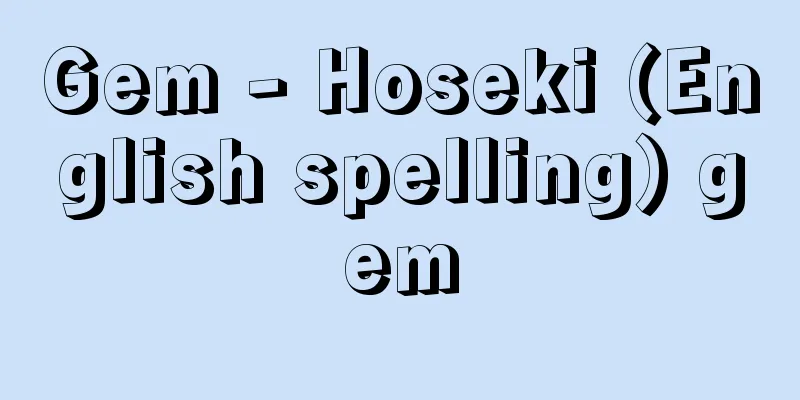Gem - Hoseki (English spelling) gem

|
A general term for minerals that can be used for decoration, combining beauty in appearance, physical hardness, and rarity. There is no clear academic definition. Also, when a substance that meets the first two conditions is synthesized and used for the purpose of a gemstone, it is called a synthetic gemstone. Many of the natural gemstones currently in use can be synthesized. When a substance that does not exist as a mineral is created and used for the same purpose, it is called an artificial gemstone (or synthetic gemstone). Isotropic zirconia (cubic zirconia) is the most famous example. Other less valuable gemstones can be processed in various ways to increase their value. The main methods are heating, pressure, gamma (gamma) radiation, and coloring. Blue topaz, blue zircon, and citrine are created by such processes. There is also a processing method in which several pieces are glued together to make it look like a large gemstone, which is often done with opals. [Akira Kato] Properties of gem mineralsExternal beauty is determined by color, transparency, brilliance, etc., and gemstones with high transparency are cut, and gemstones with certain optical properties are polished to accentuate those properties. Diamonds and other gemstones with high refractive indexes belong to the former, while star sapphires and other gemstones that show so-called rays of light (streaks of light that run in two directions from a single point) belong to the latter. Examples of gemstone colors are as follows: (1) Colorless to pale or white: Diamond, topaz, beryl, tourmaline, quartz, zircon, opal, spinel, etc. In terms of physical hardness, stones with a value of 7 or higher on the Mohs hardness scale (quartz) are selected, with turquoise being an exception, with a hardness of about 5. As for rarity, minerals with a certain degree of beautiful color, transparency, and hardness are rare in themselves. Therefore, even if a stone only meets some of these requirements, it may be used as an ornamental material, and may be called a precious stone (or, at a lower level, a semi-precious stone or a decorative stone). Stability against chemicals, heat, or direct exposure to light may also be listed as a necessary condition for a gemstone, and many hard substances meet these conditions. Minerals used as gemstones include diamond, corundum (ruby and sapphire), beryl (emerald, morganite, and aquamarine), spinel, chrysoberyl (alexandrite), topaz, garnet, zircon, tourmaline, opal, turquoise, jadeite, forsterite, sinhalite, and turfstone; and of slightly lower grades include garnet, iron garnet, andalusite, sericite, cordierite, phenacite, diopside, spodumene, coeruleanite, quartz (amethyst, citrine, black quartz, and smoky quartz), chalcedony (agate and jasper), lazurite, and amber. These are sometimes collectively referred to as precious stones. The next step, decorative stones, are feldspars, hematite, aragonite, fluorite, malachite, rhodonite, serpentine, sodalite, vesuvianite, tremolite (nephrite), and clotidite (tiger's eye). Rocks that are treated as decorative stones as well as minerals include obsidian and tektite. Charoite, a new mineral recognized in Russia in 1978, is a dense collection of beautiful pale purple fibrous crystals that is processed as decorative stones and has spread throughout the world. Pearls are often treated as gemstones, and in fact are composed of calcium carbonate, but because they are produced organically they cannot be considered minerals, and so they are not treated as gemstones here. [Akira Kato] Occurrence and place of originDiamonds are mostly found in kimberlite, or in soils and placers (alluvial deposits) formed by the decomposition of kimberlite. Those found in meteorites and ultra-high pressure metamorphic rocks are extremely fine. They are known to be found in South Africa, Russia, Brazil, China and Australia. High-quality rubies are found in recrystallized limestone, and Myanmar, Sri Lanka and India are the world's supply sources. The most important occurrences of sapphires are in basalt or in the soil and sand formed by the decomposition of basalt, and are known in Myanmar, India and Sri Lanka. Those from Australia are found in high-temperature metamorphic rocks of mudstone origin. Famous emerald producing areas include the Ural region of Russia and Colombia in South America, where they are found in biotite schist of mudstone origin or in quartz veins that cut through it. In Colombia, emeralds are also found in special carbonate rocks. Emeralds are brittle despite their hardness, and are rarely found in placer mines. Morganite is found mainly in granitic pegmatites. The largest source of aquamarine is in the state of Minas Gerais in Brazil, where it is found in granitic pegmatites. Spinel (spinel) gemstones are found in recrystallized limestone or dolomite, or in placers derived from these, and those with red to purple colors are valued as gemstones. Alexandrite, like emeralds, is found in biotite schist or pegmatite, or in placers derived from these. Topaz found in pegmatites is important, and famous production areas include Brazil, Russia, and Germany, but also Naegi in Nakatsugawa City, Gifu Prefecture, Tanakamiyama in Otsu City, Shiga Prefecture, and Kurobera in Kofu City, Yamanashi Prefecture. In the state of Utah in the United States, there is a place where topaz is found in rhyolite. Mineralogically, garnet is a group of minerals consisting of a dozen or so independent species, but the five species used as gemstones (or precious stones or ornamental stones) are cobalt garnet, bitter garnet, allyl garnet, spessartan garnet, and ferroir garnet. Cobalt garnet is found in recrystallized limestone, and Sri Lanka is famous for it. Magnesium garnet is a mineral that is formed only under high temperature and pressure conditions. It is famous for being found in eclogite from Bohemia, and good quality is also found in the kimberlite of South Africa. Ferruginous garnet occurs in gneiss, granitic pegmatite, rhyolite, etc., and spessartan garnet occurs in a similar manner. Ferrognitic garnet occurs in recrystallized limestone, ultramafic rock, greenschist, nepheline syenite, etc. Zircon found in Sri Lankan sand ores is said to be of the highest quality and highly transparent. It is thought that it probably originated from the ancient gneiss. Among the tourmaline minerals, there are three types that have gemstone properties: elbaite, liddicoatite, a new mineral, and dravite. The first two are famous in California, USA, and dravite in Madagascar. All of them are components of so-called lithium pegmatites. Dravite is found in basic igneous rocks, crystalline schists of mudstone origin, and recrystallized limestone. Among opals, so-called precious opals, which have gemstone value, are found as nodules in acidic volcanic rocks or pyroclastic rocks, or as components of sediments from groundwater rich in silica at shallow depths. Those from Mexico are examples of the former, and those from Australia are examples of the latter. In Japan, a small amount of what is called precious stone is produced in Hosaka, Nishiaizu-cho, Yama-gun, Fukushima Prefecture. Turquoise forms thin veins or clumps in rocks with a high aluminum content, such as mudstone or trachyte, and also occurs in the oxidized zones of copper deposits. Global sources of jadeite include Iran, the Sinai Peninsula, Egypt, Russia, North America, and Australia, with Turkey merely being a gateway to Europe for Iranian jadeite. Jadeite is a type of metamorphic mineral that is only formed under high-pressure conditions, and clumps are produced as the main component of albitite associated with ultramafic rocks such as serpentine. Jadeite from Myanmar and China is particularly famous, and in Japan, a jadeite production site is in Itoigawa City, Niigata Prefecture. Forsterite is a common mineral, but there are few sources of gemstones, with only a few in Australia, Myanmar, and the United States, apart from St. John's Island in the Red Sea. Sinhalaite was announced as a new mineral in 1952, after studying a gemstone that had been mistakenly identified as olivine from Sri Lanka (then Ceylon). It has the ideal formula MgAlBO 4 , and was found in recrystallized dolomite, which was collected in placer mines. It was later discovered in New York State, USA, but has no value as a gemstone. Similarly, turfite was named after Earl of Tarf in 1951, when he discovered that the "spinel" he had obtained was anisotropic, and research revealed that it was a new mineral with the chemical composition MgBeAl 4 O 8 (later corrected to Mg 3 BeAl 8 O 16 ). It has since been reported to be produced in China, Australia, and other places. [Akira Kato] Processing and use as gemstonesIn almost all cases, gemstones are polished and shaped to bring out their beauty. There are four main ways to do this: cabochon, rose, brilliant, and step. Cabochon is a method applied to opaque or translucent materials with relatively low hardness. It is finished into a shape close to a sphere or spheroid, cut parallel to the long axis, and has a bulged or flattened cross section, or a concave cross section. Those polished into a sphere are used for star sapphires, those with a bulged cross section are used for sapphires, and those with a flat cut surface are used for tiger's eye and moonstone. Rose has a low pyramid-shaped cross section, usually with 24 small triangular faces as a pyramid face on one large base, and was once applied to diamonds. Brilliant is a method used for diamonds and artificial cubic zirconia. One side is a flat top pyramid called a crown, with a total of 33 small faces, and the other side is a solid body close to a pyramid with 25 faces, and this part is called a pavilion. The edge between the two is called the girdle. The flat surface of the crown is the table, and the apex of the pavilion is a small flat surface called the curette. Currently, the brilliant cut, which has a total of 102 facets, is widely used. One of the features of the brilliant cut is that it is possible to adjust the angle of the crown and pavilion according to the refractive index of the gemstone, and design it so that all light entering from the surface is reflected. The step has a large table and parallel inclined surfaces that contact it, with the outline of an octagon with the corners of a square or rectangle rounded off, and the part equivalent to the pavilion also consists of several inclined surfaces with edges parallel to the girdle. This is a cut that is often used for tourmaline, emerald, forsterite, etc. The use of gemstones, for example diamonds, is used for industrial purposes, but it is when they are endowed with wealth value as a valuable item that directly relates to real life. Naturally, such gemstones are also important as accessories, but since ancient times, there has been a legend that a certain gemstone corresponds to each of the 12 months of the year, and that if a person born in that month wears that gemstone, it will bring them happiness. This is the origin of birthstones, which became popular in Europe around the 18th century. Currently, the most widely accepted birthstones are as follows: January (garnet), February (amethyst), March (bloodstone, red jasper), April (diamond), May (emerald), June (pearl), July (ruby), August (onate), September (sapphire), October (opalace), November (topaz), December (turquoise). [Akira Kato] Jewelry and clothingDue to differences in aesthetic values between the East and the West, in the West, gemstones that reflect light and shine brightly are preferred, and diamonds, rubies, emeralds, sapphires, and pearls have been called the five great gemstones and highly valued. In the East, the Seven Treasures (Shippou) and Seven Treasures (Shichin) are highly valued: gold, silver, coral, pearls, lapis lazuli, crystal, and agate. In Japan, gemstones that absorb light and have deep, moist colors, such as jade, coral, amber, agate, tortoiseshell, pearls, crystal, and white opals, have been particularly popular. In general, Japanese people prefer orange-colored Mexican opals, while cool-colored Australian opals are popular in the West. Cream-colored pearls, the green of emeralds and jade, and warm-colored stones such as garnets, rubies, and corals look good on Japanese skin tones. It was once said that the bright blue colors of sapphire, turquoise, lapis lazuli, and other stones which suit Caucasian people, as well as pink and black pearls, were not suitable for Japanese people, but perhaps due to the influence of birthstones, people are now free to use any stone they like. In traditional Japanese clothing, jewels that are traditionally popular in Japan have been used for finger rings, obi fasteners, hair accessories, haori cords, etc. For example, there are jeweled rings with watches set into them (as wristwatches are not in harmony with Japanese clothing), jeweled obi fasteners that can also be used as brooches for Western clothing, and juzu rings (small rosary beads worn on the fingers when traveling or for informal Buddhist ceremonies). The golden rule for Western clothing is to dress casually during the day and dress up in the evening, and the use of gemstones has naturally followed this rule. In the daytime, one enjoys the color of the stone, and in the evening, one admires the brilliance of the stone under the light, and the more transparent the stone, the more suitable it is for the atmosphere of the evening. Stones that go well with evening formal wear include the five major gemstones or seven major gemstones mentioned above (pearl is excluded from the five major gemstones, and jade, cat's eye, and alexandrite are added), as well as star ruby, star sapphire, moonstone, opal, amethyst, and topaz. Stones suitable for daytime wear include garnet, amethyst, coral, aquamarine, sardonyx, turquoise, peacock, lapis lazuli, amber, and agate. However, diamonds and pearls are considered to be all-purpose stones that can be worn both day and night, and the time, place, and occasion (TPO) rules for gemstones have changed significantly today. You can enjoy the look and feeling of each stone according to your personal preferences, seasons, and ages, without being bound by rules. [Hirano Yuko] Cultural History of GemstonesModern people find gemstones to be beautiful due to their color and light, and because of their scarcity, they are considered valuable items, but this value standard has not necessarily been universal throughout history, or even universal. In its most common form, gemstones have been used since ancient times as "tama," but what was called "tama" varied depending on the era and region. In Japan, magatama and kudatama jewels made of jade began to be made during the Jomon period, and became popular as accessories during the Yayoi and Kofun periods, and "tama" appears in Japanese mythology as one of the three sacred treasures. In China, the character for "king" is said to have come from a pictograph of three jade "tama"s lined up. However, it was the development of precious metal crafts, especially inlay work, in Europe that led to the rise in value of gemstones. The Sumerians created magnificent necklaces by juxtaposing golden rosary beads with lapis lazuli, carnelian, agate, jasper, marble and silver. They were also interested in rings, and created pieces in which gold plates were soldered to the base material as mountings for gemstones, and the size of the gemstones was adjusted and fixed with adhesive. Other Assyrian kings' monuments, such as the statue of the sun god Shamash carved on the stone pillar of the Babylonian king Hammurabi, are studded with an astonishing amount of precious stones. Meanwhile, in Egypt, lapis lazuli, turquoise and amethyst were already used in the bracelets of 1st Dynasty queens. The lavish funerary goods found in the tomb of King Tutankhamun of the 18th Dynasty are famous. Just to mention the coffin lid, which features a high-relief sculpture of the king, the collar is decorated with a cloisonné belt, and the lower body and arms, which appear to be protected by two goddesses in the form of vultures with outstretched wings, are decorated with lapis lazuli, carnelian, emerald and opaque polychrome glass. Homer mentions early Greek jewels in his Iliad, in which he describes the shield of Achilles, and in the same place Schliemann discovered gemstones inlaid with gold and other materials belonging to the Mycenaean culture. Popular beliefs about gemstones are known all over the world. The hardness, brilliance, and beautiful colors of gemstones are believed to be the root of why people believe that gemstones have mystical and special powers, and they are often carried as talismans. For example, in ancient India, rubies were believed to bring health, wealth, wisdom, and happiness to their owners, and in medieval Europe, they were believed to have the power to counteract poison and ward off lightning and cholera. The belief in birthstones also originated from these beliefs. In addition, various popular beliefs, including the custom of the Chaldeans, who were skilled in astrology, to assign gemstones to the 12 months of the year, gave rise to the belief that wearing a gemstone for each month would bring happiness, but as the value of gemstones increased in later times, this extravagant act became impossible, and the custom changed to wearing only the gemstone for the month of one's birth. Another important role of gemstones was in their use as medicines. Emeralds, rubies, sapphires, garnets, and pearls were prominent in medieval medicine, and were usually prepared in powder form. There are also records of bloodstones being applied to affected areas as a treatment for hemostasis, and the popular belief that jadeite is good for relieving pain in the side is well known. The etymology of the word jadeite comes from the Spanish word for "side stone." It is said that ancient Greek jewelers would look at emeralds to relieve tired eyes, a method that has been recognized by modern science. The emerald was also thought to cure throat and jaw diseases, and was also considered a gemstone that wards off evil. Looking at the symbolism of these gemstones, garnets represent chastity, friendship, and fidelity, while amethyst is a symbol of high virtue, ideals, and authority. Other examples include diamonds, which symbolize chastity and purity, soothe anger, give courage in love, and do not destroy the trust between husband and wife, and pearls, which symbolize wealth and virginity. [Yuji Seki] "The Science of Gems" by P.J. Fisher, translated by Sakigawa Noriyuki (1970, Kyoritsu Shuppan)" ▽ "The Story of Gems" by Sunagawa Ichiro and Kanoki Shosuke (1970, Idemitsu Shoten)" ▽ "Jewelry Museums of the World - Jewelry Design Since the Renaissance" by Jean Lanlier and Marie-Anne Pini, translated by Hishida Yasuhiko and Tanabe Sadanosuke (1972, Kamakura Shobo)" ▽ "The World of Gems" by H. Bank, translated by Kawada Isao (1974, Nitto Shobou Shuppan)" ▽ "Jewelry Handbook" by Terauchi Takashi and supervised by Chikayama Akira (1975, Bookman)" ▽ "The Complete Book of Gems" by Sakai Mieko and Ikeda Yutaka (1977, Shufu to Seikatsusha)" ▽ "Gemology - The Origin, Properties and Identification of Gems" by Robert Webster, supervised by Sunagawa Ichiro (1980)" ▽ "Gemology Encyclopedia," edited by Chikayama Akira, revised edition (1983)" ▽ "Gemstones -- Their Beauty and Science," written by Chikayama Akira (1984, Japan Gemological Association)" ▽ "Gemstones and Jewelry Dictionary, revised edition (1985, Kodansha), supervised by Ototake Hiroshi and Shiotsuki Yaeko" ▽ "The Story of Gems," written by Shiramizu Haruo and Aoki Yoshikazu (1989, Gihodo Publishing)" ▽ "Visual Museum 25: Crystals and Gems" (1992, Dohosha Publishing)" ▽ "The Complete Photographic Encyclopedia of Gems -- 130 Gems of the World, Full Color," written by C. Hall, photographed by H. Taylor, translated by Miyata Nanae (1996, Nihon Vogue-sha)" ▽ "Pocketpedia: Crystals and Gems," written by Emma Foer and supervised by Sunagawa Ichiro (1998, Kinokuniya Shoten)" ▽ "The Archaeology of Gems, by Jack Ogden, supervised by Koyama Shuzo, translated by Sonoda Naoko (1998, Gakugei Shorin)" ▽ "Jewels, by Suwa Kyoichi, 3 volumes (1999-2002, Sekai Bunka Publishing)" ▽ "The Power of Gems: Good Fortune Dwells in Form, by Kitade Yukio (2003, Seikyusha) " ▽ "Jewels, by Sakigawa Noriyuki (Hoikusha, Color Books)" ▽ "The Book to Become Expert on Gems, by F.H. Pugh, translated by Harada Kaoru (Kodansha, Bluebacks)" ▽ "The Book of Gems, by Shiotsuki Yaeko (Kobunsha, Kappa Holmes)" ▽ "Jewels Speak, by Sunagawa Ichiro (Iwanami Shinsho)" [References] | | | | | |Garnet| | | | | |Dust |Dust garnet| | | | | | | | | |Cat | | | | | | | |©Central Gem Laboratory "> Aquamarine Made in Kurodaira, Kofu City, Yamanashi Prefecture ©Shogakukan Aquamarine (Raw Stone) ©Central Gem Laboratory "> Amazonite Made in Finland ©Shogakukan "> Amazonite (Raw Stone) ©Central Gem Laboratory "> Amethyst Produced in Yusenji, Komatsu City, Ishikawa Prefecture ©Shogakukan Amethyst (Raw Stone) ©Central Gem Laboratory "> Emerald ©Central Gem Laboratory "> Emerald (Beryl) [Raw Stone] ©Central Gem Laboratory "> opal ©Central Gem Laboratory "> Opal (rough stone) ©Central Gem Laboratory "> Garnet ©Central Gem Laboratory "> Garnet (Raw Stone) ©Central Gem Laboratory "> Kunzite ©Central Gem Laboratory "> sapphire ©Central Gem Laboratory "> Sapphire (Corundum) [Raw Stone] On the right is blue zircon ©Central Gem Laboratory "> Zircon From the left: Dendritic (grass-containing quartz), different colors, golden quartz, rock crystal (grass-containing) ©Central Gem Laboratory "> crystal Made in Ida, Arkansas, USA ©Masutomi Geological Society Foundation Quartz (rough stone) The photo shows a pale blue spinel ©Central Gem Laboratory "> Spinel Red spinel ©Central Gem Laboratory "> Spinel (raw stone) ©Central Gem Laboratory "> Sodalite Southwest Africa ©Masutomi Geological Society Foundation "> Sodalite (rough stone) ©Central Gem Laboratory "> diamond ©Central Gem Laboratory "> Diamond (rough stone) ©Central Gem Laboratory "> Tanzanite On the right is blue topaz ©Central Gem Laboratory "> Topaz ©Central Gem Laboratory "> Tiger's Eye ©Central Gem Laboratory "> Turquoise ©Central Gem Laboratory "> Turquoise (Raw Stone) Pink tourmaline in the center, vanadium tourmaline on the right ©Central Gem Laboratory "> Tourmaline ©Central Gem Laboratory "> Tourmaline (rough stone) On the right is a cat's eye ©Central Gem Laboratory "> Nephrite ©Central Gem Laboratory "> Jade ©Central Gem Laboratory "> Hiddenite ©Central Gem Laboratory "> Peridot ©Central Gem Laboratory "> Moonstone ©Central Gem Laboratory "> Agate ©Central Gem Laboratory "> Morganite ©Central Gem Laboratory "> Lapis lazuli (lazurite) [rough stone] ©Central Gem Laboratory "> Ruby ©Central Gem Laboratory "> Ruby (Corundum) [Raw Stone] ©Central Gem Laboratory "> Rose Quartz ©Shogakukan "> Gemstone Cut Styles(1) ©Shogakukan "> Gemstone Cut Formats (2) ©Shogakukan "> Gemstone Cut Formats (3) ©Shogakukan "> The various parts of a brilliant cut diamond… ©Shogakukan "> Diamond Carat Chart Source: Shogakukan Encyclopedia Nipponica About Encyclopedia Nipponica Information | Legend |
|
外見上の美しさ、物理的な硬さ、産出の希少性を兼ね備えた、装飾に供しうる鉱物の総称。学術的に明確な定義は存在しない。また最初の2条件を満たす物質を合成して宝石としての目的に供するとき、これを合成宝石という。現在使用されている天然の宝石の多くは合成が可能である。鉱物として存在しないものをつくって同様の目的に用いるとき、これを人造宝石(または人工宝石)という。等方性ジルコニア(キュービック・ジルコニア)はそのもっとも有名な例である。ほかに価値の低いものをさまざまな方法で加工して価値を高めることもある。加熱、加圧、γ(ガンマ)線照射、着色などがそのおもな方法で、青色トパーズ、青色ジルコン、黄水晶などはこうした処理でつくられたものである。また、複数の切片を張り合わせて一つの大きな宝石にみせるというような処理方法もあり、オパールではしばしば行われている。 [加藤 昭] 宝石となる鉱物の諸性質外見上の美しさは、色、透明度、輝きなどによって支配されるが、透明度の高いものはカット加工され、またある種の光学的特性をもつような場合は、その特性がより強調されるように研磨加工される。ダイヤモンドをはじめとして、屈折率の高いものは前者に、スター・サファイアなどいわゆる光芒(こうぼう)(一点を中心として二方向へ走って光る筋(すじ))を示すものは後者に属する。宝石の色としては以下の例がある。 (1)無色~淡色あるいは白色 ダイヤモンド、トパーズ、緑柱石、電気石、水晶、ジルコン、たんぱく石(オパール)、スピネルなど 物理的な硬さとしては、モース硬度にして7(石英)以上の値をもつものが選ばれるが、トルコ石は例外的に硬度5程度である。産出の希少性については、ある程度美しい色、透明度、硬さをもった鉱物は、それだけでまれである。したがって、これらの要素のうち一部のみを満足する場合でも装飾の素材となることがあり、貴石(さらに程度が下がれば半貴石)、飾り石などのような用語でよばれることもある。また宝石としての必要条件に、薬品、熱あるいは光線の直射に対する安定性もあげられることがあるが、硬度の高い物質は、多くこれらの条件を満たしている。 宝石として用いられる鉱物としては、ダイヤモンド、コランダム(ルビーおよびサファイア)、緑柱石(エメラルド、モルガナイトおよびアクアマリン)、スピネル、金緑石(アレキサンドライト)、トパーズ、ざくろ石、ジルコン、電気石、たんぱく石(オパール)、トルコ石(トルコ玉ともいう)、ひすい輝石、苦土橄欖石、シンハラ石、ターフ石などがあり、これらよりやや等級の劣るものとしては、苦礬(くばん)ざくろ石、鉄礬ざくろ石、紅柱(こうちゅう)石、珪(けい)線石、菫青石、フェナク石、透輝石、リチア輝石、灰簾(かいれん)石、石英(紫水晶、黄水晶、黒水晶、煙水晶)、玉髄(ぎょくずい)(めのう、碧玉(へきぎょく))、青金石、こはくなどがあり、貴石という名称で一括されることもある。 さらに次の段階である飾り石としては、長石類、赤鉄鉱、あられ石、蛍石、くじゃく石、ばら輝石、蛇紋石、方ソーダ石、ベスブ石、透閃(とうせん)石(軟玉)、クロチド閃石(虎目石(とらめいし))などがある。鉱物なみに飾り石としての扱いをされる岩石に黒曜石とテクタイトがある。また1978年にロシアで認定された新鉱物チャロ石charoiteは美しい淡紫色の繊維状結晶の緻密(ちみつ)な集合をなし、飾り石として加工され、世界各地に広まっている。 真珠は宝石として扱われることも多く、事実、成分的には炭酸カルシウムからなっているが、有機的に生成されるため鉱物とはいいがたく、ここでは宝石として取り扱わない。 [加藤 昭] 産状および産地ダイヤモンドは、そのほとんどがキンバレー岩中、あるいはこれが分解して生じた土壌、砂鉱(さこう)(漂砂鉱床)中に産する。隕石(いんせき)や超高圧変成岩中のものはきわめて微粒である。南アフリカ共和国、ロシア、ブラジルのほか、中国やオーストラリアでも産出が知られている。ルビーの良質のものは、再結晶石灰岩中のもので、ミャンマー、スリランカ、インドなどが世界の供給源である。サファイアの産状としては、玄武岩あるいはこの分解によって生じた土砂中のものが重要で、ミャンマー、インド、スリランカなどに知られる。オーストラリア産のものは、泥質岩起源の高温生成の変成岩中のものである。 エメラルドの産地としては、ロシアのウラル地方、南米コロンビアなどが有名で、いずれの産地でも泥質岩起源の黒雲母(うんも)片岩、あるいはこれを貫く石英脈中に産する。コロンビアでは、特殊な炭酸塩岩中に産するエメラルドもある。エメラルドは硬度の高いわりにもろく、砂鉱に入ることはほとんどない。モルガナイトは、おもに花崗(かこう)岩質ペグマタイト中に産する。アクアマリンの最大産地はブラジルのミナス・ジェライスMinas Gerais州で、花崗岩質ペグマタイト中に産する。スピネル(尖晶(せんしょう)石)のうち宝石となるものは、再結晶石灰岩あるいは苦灰岩中か、これらに由来する砂鉱中のもので、赤から紫系統の色のものが宝石として重要視される。アレキサンドライトはエメラルド同様黒雲母片岩中のものとペグマタイト中のもの、あるいはこれらを源とする砂鉱などから産する。トパーズはペグマタイト中のものが重要で、ブラジル、ロシア、ドイツなどに著名産地があるが、日本の岐阜県中津川市苗木(なえぎ)、滋賀県大津市田上(たなかみ)山、山梨県甲府市黒平(くろべら)なども有名である。なおアメリカのユタ州では、流紋岩中に美晶を産する所がある。ざくろ石は鉱物学的には十数種の独立種からなる一つの鉱物群であるが、宝石(あるいは貴石、飾り石)として用いられるものは、灰礬(かいばん)ざくろ石、苦礬(くばん)ざくろ石、鉄礬ざくろ石、満礬ざくろ石、灰鉄ざくろ石の5種である。灰礬ざくろ石は再結晶石灰岩中のもので、スリランカ産のものが有名である。苦礬ざくろ石は高温高圧条件下でのみ生成される鉱物で、ボヘミア産のエクロジャイト中のものが名高く、また南アフリカ共和国のキンバレー岩中にも良質のものがある。鉄礬ざくろ石は、片麻(へんま)岩、花崗岩質ペグマタイト、流紋岩などの中に産し、満礬ざくろ石もほぼ同様の産状をもっている。灰鉄ざくろ石は再結晶石灰岩、超塩基性岩、緑色片岩、霞石閃長(かすみいしせんちょう)岩中などに産する。 ジルコンは、スリランカの砂鉱中のものが透明度が高く、最上質といわれている。これはおそらく時代の古い片麻岩に起源をもつものと考えられる。電気石系列の鉱物中、宝石の要素をもつものは、リチア電気石elbaiteと新鉱物の灰リチア電気石(リディコート石liddicoatite)、苦土電気石draviteの3種で、始めの2種はアメリカのカリフォルニア州、苦土電気石はマダガスカル島のものが有名で、いずれもいわゆるリチウムペグマタイトの構成鉱物である。苦土電気石は塩基性火成岩、あるいは泥質岩起源の結晶片岩、再結晶石灰岩中などに産する。たんぱく石(オパール)のうちで宝石としての価値をもつ、いわゆる貴たんぱく石は、酸性火山岩あるいは火砕岩中の団塊として、もしくは地下浅所でケイ酸分に富んだ地下水からの沈殿物の構成成分として産し、メキシコ産のものは前者の、オーストラリア産のものは後者の例である。日本では、福島県耶麻(やま)郡西会津(にしあいづ)町宝坂(ほうさか)でまれに貴たんぱく石といわれているものを少量産する。トルコ石は泥質岩あるいは粗面岩などアルミニウム分の多い岩石中に細脈や塊をなし、また銅鉱床の酸化帯に産する。世界的な産地としては、イラン、シナイ半島、エジプト、ロシア、北アメリカ、オーストラリアなどで、トルコは単にイラン産のもののヨーロッパへの窓口であったにすぎない。ひすい輝石は高圧条件下でのみ生成される一種の変成鉱物で、塊状をなすものは、蛇紋岩のような超塩基性岩に伴われる曹長岩の主成分として産する。ミャンマー、中国のものはとくに有名で、日本でも新潟県糸魚川(いといがわ)市にひすい輝石の産地がある。苦土橄欖石は普通に産する鉱物であるが、宝石用のものの産地は少なく、紅海のセント・ジョーンズ島以外には、オーストラリア、ミャンマー、アメリカなどにいくつかの産地があるだけである。シンハラ石は、1952年、スリランカ(当時のセイロン)産の橄欖石と誤認されていた宝石を研究して新鉱物として発表したもので、理想式MgAlBO4、再結晶苦灰岩中に生成されたものが砂鉱に入り、そこでも採集された。その後アメリカ・ニューヨーク州からも発見されたが、宝石としての価値はない。ターフ石も同様に、1951年イギリスのターフ伯爵が、自分の入手した「スピネル」が非等方性であることを発見し、研究の結果MgBeAl4O8(のちMg3BeAl8O16に訂正)の化学組成をもつ新鉱物であることが判明し、彼にちなんで命名されたものである。その後中国、オーストラリアなどからも産出が報告されている。 [加藤 昭] 宝石としての加工・利用宝石はほとんどすべての場合、表面を研磨し、またその美しさを十分発揮できるように整形するのが普通で、その方法には代表的なものとして次の四つがある。すなわち、カボションcabochon、ローズrose、ブリリアントbrilliantおよびステップstepである。 カボションは比較的低硬度の不透明ないし半透明のものに対して応用される方法で、球あるいは回転楕円(だえん)体に近い形に仕上げたもの、これを長軸に平行に切り、断面を膨らませたものや断面を平らにしたもの、また逆に凹(へこ)ませたものなどがあり、球状に磨かれるものにはスター・サファイア、断面を膨らませた形にするものにはたんぱく石など、平らな切断面のものは虎目石、月長石などに応用されている。ローズは低い錐(きり)状の断面をもつもので、通常は一つの大きな底面に錐(すい)面として24個の小三角面をもつもので、かつてはダイヤモンドに適用された。ブリリアントは、ダイヤモンドや人造のキュービック・ジルコニアに用いられている方法である。一方はクラウンcrownとよばれる頂部が平面の角錐台で、合計33個の小さい面をもち、反対側は25個の面をもつ角錐に近い立体で、この部分をパビリオンpavillionという。両者の境界の稜(りょう)にあたる部分をガードルgirdleという。クラウンの平面部はテーブルtable、パビリオンの頂点はキュレットcuretteとよばれる小さな平面となっている。現在は総計102個の面をもつブリリアント・カットが広く用いられている。宝石の屈折率に応じてクラウンとパビリオンの角度を調節し、表面から入った光線がすべて反射されるように設計可能なのがブリリアント・カットの特徴の一つである。ステップは正方形あるいは長方形の角をとった八角形の輪郭に大きなテーブルとこれに接する平行な傾斜面をもち、パビリオン相当の部分もガードルに平行な稜をもったいくつかの傾斜面からなっている。これは電気石、エメラルド、苦土橄欖(かんらん)石などによく用いられるカットである。 宝石の利用は、たとえばダイヤモンドにおいては、世界全体の産額の90%以上が工業用の目的に使用されているが、実生活と直接関係するのは、一つの貴重品として財産価値を賦与された場合である。当然そのような宝石は、装身具としての重要性も大きいが、古くから、ある特定の宝石を1年12か月に対応させ、その月に生まれた人がその宝石を身につけると幸福をもたらすという言い伝えがあった。これが誕生石のおこりで、18世紀ごろからヨーロッパで流行することとなった。現在、誕生石としてもっとも広く受け入れられているものは次のとおりである。1月(ざくろ石)、2月(紫水晶)、3月(血石(けっせき)、赤色の碧玉)、4月(ダイヤモンド)、5月(エメラルド)、6月(真珠)、7月(ルビー)、8月(縞(しま)めのう)、9月(サファイア)、10月(たんぱく石)、11月(トパーズ)、12月(トルコ石)。 [加藤 昭] 宝石と装い東西の美意識の違いから、西洋では光を反射して鮮やかに輝く宝石が好まれ、ダイヤモンド、ルビー、エメラルド、サファイア、真珠が五大宝石とよばれて珍重されてきた。東洋では七宝(しっぽう)、七珍(しっちん)といわれる金、銀、サンゴ、真珠、瑠璃(るり)(ラピスラズリ)、玻璃(はり)(水晶)、めのうが貴ばれる。日本では、光を吸収してしっとりと深い色彩をたたえた、ひすい、サンゴ、こはく、めのう、べっこう、真珠、水晶、白色オパールなどがとくに好まれてきた。一般的に、オレンジ系のメキシコオパールを好む日本人に対して、欧米では寒色系のオーストラリアオパールに人気がある。日本人の肌色には、真珠ならばクリーム系、エメラルドやひすいのグリーン、そしてざくろ石(ガーネット)やルビー、サンゴなどの暖色系の石がよく映える。白色人種に似合うサファイア、トルコ石、ラピスラズリなどの鮮やかなブルー、そしてピンク系やブラック系の真珠は日本人向きではないといわれていたが、誕生石の影響もあってか、現在では好みの石を自由に用いている。 和装では、指輪、帯留、髪飾り、羽織の紐(ひも)などに、伝統的な日本人好みの宝石を用いてきた。たとえば、時計をセットした宝石入りの指輪(和服には腕時計が不調和なので)、洋装のブローチにもなる宝石の帯留、数珠(じゅず)リング(旅先や略式の仏事に用いる指にはめる小さな数珠)などがある。 洋装の場合、昼間はカジュアルに、夕方以後はドレッシーにというのが装いの鉄則であるが、宝石の使用も当然これに従ってきた。昼の光のなかでは石の色彩を楽しみ、夜の照明の下では石の輝きを愛(め)でることになり、透明度の高いものほど夜の雰囲気にふさわしい石となる。夜の正装にあう石は、先に述べた五大宝石、または七大宝石(五大宝石のうち真珠を除き、ひすい、猫目石、アレキサンドライトを加える)をはじめ、スタールビー、スターサファイア、ムーンストーン、オパール、アメシスト、トパーズなど。 昼の装いにふさわしい石は、ざくろ石、アメシスト、サンゴ、アクアマリン、サードオニクス、トルコ石、くじゃく石、ラピスラズリ、こはく、めのうなどである。しかしダイヤモンドと真珠は、昼夜を問わず使ってもよいオールマイティの石とされ、今日では宝石のTPO(時、所、場合)は大きく崩れてきている。規則にとらわれず個人の好みで、季節によって、年齢によって、それぞれの石のもつ外観やフィーリングを楽しむことができる。 [平野裕子] 宝石の文化史宝石は、現代人がその色と光に美しさを感じ、絶対量の少なさも加わって貴重品として貴んでいるが、こうした価値規準が歴史上普遍な、あるいは汎(はん)世界的なものであったとは限らない。もっとも一般的な形では、「たま」として古くから用いられていたが、何を「たま」とよぶかは、時代や地域によって異なっていた。日本では縄文時代から玉(ぎょく)製の勾玉(まがたま)や管玉(くだたま)がつくられ始め、弥生(やよい)、古墳時代に装身具として盛行し、日本神話のなかでも三種の神器の一つとして「たま」は登場する。中国でも「王」という字がひすいの「たま」を三つ連ねた象形文字からきたものといわれている。 しかし、宝石として価値を高めるようになるのは、ヨーロッパでの貴金属工芸、とくに象眼(ぞうがん)細工の発達に負うところが大きい。シュメール人は、黄金の数珠(じゅず)玉に瑠璃(るり)や紅玉髄(こうぎょくずい)、めのうや碧玉(へきぎょく)、大理石や銀を並置させ、みごとな首飾りなどをつくりだしている。指輪にも関心をもった彼らは、黄金板を宝石のはめ込み台として生地(きじ)にはんだ付けし、宝石の大きさを調整して接着剤で固定した作品を生み出している。 このほか、バビロニアの王ハムラビの石柱に彫刻された太陽神シャマシュの像をはじめとして、アッシリアの諸王の記念碑には、驚くほどの量の宝石がちりばめられている。一方エジプトでも、すでに第1王朝の王妃の腕飾りにラピスラズリ、トルコ石、アメシストが用いられている。第18王朝のツタンカーメン王の墳墓で発見された副葬品の豪華さは有名である。国王の像を高浮彫りにした棺の蓋(ふた)だけに言及しても、七宝(しっぽう)細工の帯で襟が装飾され、翼を広げたハゲタカの形をした二女神が庇護(ひご)するようにみえる下半身と腕の部分は、瑠璃、紅玉髄、緑長石、不透明多彩のガラスで飾られている。 初期ギリシア時代の宝石については、ホメロスが『イリアス』のなかでアキレウスの盾を記述しながら触れているし、同じギリシアの土地から、ミケーネ文明に属する黄金などで象眼した玉石が、シュリーマンの手で発見されている。 宝石に関する俗信は世界各地で知られる。宝石のもつ硬度、輝き、美しい色彩が、神秘的な、特別な力をもつと信仰される理由の根源にあると考えられ、護符として携帯することが多い。たとえばルビーは、古代インドでは持ち主に健康や富、知恵や幸福をもたらすとされ、中世ヨーロッパでも毒消し、落雷とコレラよけの効力をもつとされていた。誕生石の信仰も元をただせば、こうした信仰から生まれた。また、宝石を1年の12か月に割り当てるという占星学にたけたカルデア人の風習をはじめとしたさまざまな俗信からは、月々の宝石を身につければ幸福になるという信仰が生まれるが、後代宝石の価値の上昇とともにこのぜいたくな行為が不可能になり、自分の生まれ月の宝石だけを身につける習慣に変わっていった。 宝石のもう一つの重要な役割は、医薬として用いられたことにある。エメラルド、ルビー、サファイア、ざくろ石、真珠などは、中世医学のなかで堂々と取り上げられている薬であり、通常粉末にしたものを調合する。また、止血療法として血石(けっせき)を患部にあてがうという記録や、わき腹の痛みを和らげるのには「ひすい」がよいという俗信はよく知られている。とくにひすいjadeiteの語源は、スペイン語の「わき腹の石」に由来している。古代ギリシアの宝石細工の職人たちはエメラルドを見ては目の疲れをいやしていたというが、この方法は現代科学でも認められている。このエメラルドは、のどとあごの病気を治すものとも考えられる一方で、悪魔を退ける宝石とみなされていた。こうした宝石のもつ象徴性に目を向けると、ざくろ石が貞操、友愛、忠実を表現しているし、アメシストは高い徳と理想、権威のシンボルであった。このほか、貞操、純粋を象徴し、怒りを和らげ恋の勇気を与え、夫婦間の信頼を壊さぬ宝石としてダイヤモンドを、また富や処女の象徴として真珠をあげることができる。 [関 雄二] 『P・J・フィッシャー著、崎川範行訳『宝石の科学』(1970・共立出版)』▽『砂川一郎・鹿子木昭介著『宝石の話』(1970・出光書店)』▽『ジャン・ランリエ、マリー・アンヌ・ピニ著、菱田安彦・田辺貞之助訳『世界の宝石美術館――ルネッサンス以後のジュウリー・デザイン』(1972・鎌倉書房)』▽『H・バンク著、川田功訳『宝石の世界』(1974・日貿出版社)』▽『寺内隆著、近山晶監修『宝石手帖』(1975・ブックマン社)』▽『酒井美恵子・池田裕著『宝石全書』(1977・主婦と生活社)』▽『ロバート・ウェブスター著、砂川一郎監訳『宝石学gems――宝石の起源・特性・鑑別』(1980)』▽『近山晶編著『宝石学必携』新訂(1983)』▽『近山晶著『宝石――その美と科学』(1984・以上全国宝石学協会)』▽『乙竹宏・塩月弥栄子監修『宝石宝飾事典』改訂版(1985・講談社)』▽『白水晴雄・青木義和著『宝石のはなし』(1989・技報堂出版)』▽『『ビジュアル博物館25 結晶と宝石』(1992・同朋舎出版)』▽『C・ホール著、H・テイラー写真、宮田七枝訳『完璧版 宝石の写真図鑑――オールカラー世界の宝石130』(1996・日本ヴォーグ社)』▽『エンマ・フォーア著、砂川一郎監修『ポケットペディア 結晶と宝石』(1998・紀伊國屋書店)』▽『ジャック・オグデン著、小山修三監修、園田直子訳『宝石の考古学』(1998・学芸書林)』▽『諏訪恭一著『宝石』全3巻(1999~2002・世界文化社)』▽『北出幸男著『宝石の力――幸運は形に宿る』(2003・青弓社)』▽『崎川範行著『宝石』(保育社・カラーブックス)』▽『F・H・プー著、原田馨訳『宝石に強くなる本』(講談社・ブルーバックス)』▽『塩月弥栄子著『宝石の本』(光文社・カッパ・ホームス)』▽『砂川一郎著『宝石は語る』(岩波新書)』 [参照項目] | | | | | | | | | | | | | | | | | | | | | | | | | | | | | | | | | | | | | | | | | | | | | | |©中央宝石研究所"> アクアマリン 山梨県甲府市黒平産©Shogakukan"> アクアマリン〔原石〕 ©中央宝石研究所"> アマゾナイト フィンランド産©Shogakukan"> アマゾナイト〔原石〕 ©中央宝石研究所"> アメシスト(紫水晶) 石川県小松市遊泉寺産©Shogakukan"> アメシスト(紫水晶)〔原石〕 ©中央宝石研究所"> エメラルド ©中央宝石研究所"> エメラルド(緑柱石)〔原石〕 ©中央宝石研究所"> オパール ©中央宝石研究所"> オパール(たんぱく石)〔原石〕 ©中央宝石研究所"> ガーネット(ざくろ石) ©中央宝石研究所"> ガーネット(ざくろ石)〔原石〕 ©中央宝石研究所"> クンツァイト(クンツ石) ©中央宝石研究所"> サファイア ©中央宝石研究所"> サファイア(コランダム)〔原石〕 右はブルージルコン©中央宝石研究所"> ジルコン 左からデンドリティック(草入り水晶)、色違い、ゴールデンクォーツ、ロッククリスタル(草入り)©中央宝石研究所"> 水晶 アメリカ アーカンソー州アイダ産©公益財団法人益富地学会館"> 水晶〔原石〕 写真は淡青色のスピネル©中央宝石研究所"> スピネル 紅色のスピネル©中央宝石研究所"> スピネル(尖晶石)〔原石〕 ©中央宝石研究所"> ソーダライト アフリカ南西部産©公益財団法人益富地学会館"> ソーダライト〔原石〕 ©中央宝石研究所"> ダイヤモンド ©中央宝石研究所"> ダイヤモンド〔原石〕 ©中央宝石研究所"> タンザナイト 右はブルートパーズ©中央宝石研究所"> トパーズ ©中央宝石研究所"> 虎目石(タイガーズアイ) ©中央宝石研究所"> トルコ石(ターコイズ) ©中央宝石研究所"> トルコ石(ターコイズ)〔原石〕 中央はピンクトルマリン、右はバナジウムトルマリン©中央宝石研究所"> トルマリン ©中央宝石研究所"> トルマリン(電気石)〔原石〕 右はキャッツアイ©中央宝石研究所"> 軟玉(ネフライト) ©中央宝石研究所"> ひすい ©中央宝石研究所"> ヒデナイト ©中央宝石研究所"> ペリドット ©中央宝石研究所"> ムーンストーン ©中央宝石研究所"> めのう ©中央宝石研究所"> モルガナイト ©中央宝石研究所"> ラピスラズリ(ラズライト)〔原石〕 ©中央宝石研究所"> ルビー ©中央宝石研究所"> ルビー(コランダム)〔原石〕 ©中央宝石研究所"> ローズクォーツ(紅水晶) ©Shogakukan"> 宝石のカット形式(1) ©Shogakukan"> 宝石のカット形式(2) ©Shogakukan"> 宝石のカット形式(3) ©Shogakukan"> ダイヤモンドのブリリアント・カット各部… ©Shogakukan"> ダイヤモンドのカラット表 出典 小学館 日本大百科全書(ニッポニカ)日本大百科全書(ニッポニカ)について 情報 | 凡例 |
>>: Houseido Kisanji - Houseido Kisanji
Recommend
Khin
…This is the first period of the Baikal Neolithic...
Iwagane-sou (English name) bamboo fern
A perennial fern of the Caprifoliaceae family (ill...
Sineus
…They were called Varyagi, or “Rus Beyond the Sea...
Kaminaga Ryougetsu - Kaminaga Ryougetsu
…Enka began to change from hard-line to soft-line...
Si-tu Mei-tang (English name)
[Life] Tongzhi 7 (1868).4.3. Guangdong, Kaiping Di...
Deposit Law - Kyotakuho
This law stipulates the procedures for deposits. I...
Komissar (English spelling)
In Russia and the Soviet Union, this refers to a c...
Content of consciousness - Ishikinaiyou
…This mechanism can be broadly divided into two s...
Gamopetalae
…It includes about 60 orders, 300 families, 10,00...
Yamahata
A field in the mountains. A field in the mountaino...
Single-axle truck - Fig truck
...However, because the length of the body of a f...
External rotation surgery - Gaikai Tenjutsu (English) external version
When the fetus is in a breech position (breech bab...
Survival Curve - Seizon Kyokusen
A curve that shows the relationship between the su...
Perceptron
…The first term represents the strengthening of t...
Ivy Geranium
...There are groups such as the flower geraniums ...




![Wakayanagi [town] - Wakayanagi](/upload/images/67cd410471d5d.webp)




